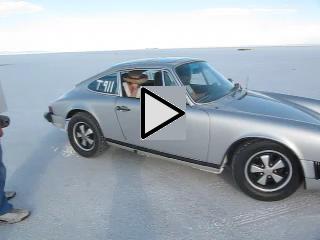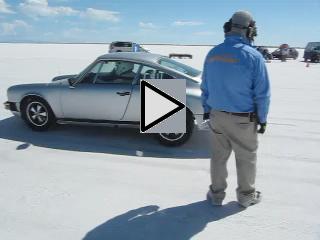Porsche 9Electric Salt Flats Debut

The video is my favorite, my crew took a little joyride at the end of the day. Note the wheelspin in 1st and 2nd gear, and the passenger getting thrown back!
The car is an old Porsche 911, converted to electric power. I pulled several late nights, and an all nighter before the last day of the Salt Flats event http://www.saltflats.com . The car was far from done, but I was bound and determined to start getting some real life Salt Flats experience!
It had rained, delaying the event by a day. The Salt Flats were still partially under water. This video shows the 100 meters of so of puddle you had to drive through to get to the raceway. Fortunately the course and pits were dry!

Here the tech inspector is giving the 9Electric a close look.
Technical note: The battery restraints were designed to meet both http://www.NEDRA.com (electric drag racing) and SCTA (land speed) safety specs. The batteries are Optima Blue Tops, 8 of them wired for 48 Volts.
The campaign sign keeps salt flrom flipping up into the motor. The barely visible panty hose covers the motor inlet to keep salt out.
Technical note: The motor is a Bulgarian forklift motor, an 11 inch Kostov sepex DC motor. With 48 V applied to both the field and armature, it would spin about 1570 rpm. This is a property of sepex and shunt motors -- they work hard to spin at key speed, making them good choices for elevators and conveyer belts. Loaded down below this speed, the motor will draw current and try to accelerate. Pushed faster than this speed, and the motor will try to slow down by pumping electricity into the batteries, known as "regenerative braking."
It's a long push to the next plug for charging! We pushed the car to the starting line. We did this for safety, to conserve battery power, and to keep the motor as cool as possible. Video pushing to line
Here the race officials are checking I know what to do before my first run.
I'm reminded of the song "I can't drive 55!" but as in can't go that fast! The car only hit 40 mph, but will be much faster in 2010.
Technical note: I didn't have time for a proper controller, so control was via an on/off switch, slipping the clutch, and shifting gears. I also didn't have time to make rear battery racks, so I just ran the car on 8 Optima Blue Top D34M batteries, wired for 48 Volts. I didn't even have time to properly test the car (that would have necessitated battery recharging time), except to pull it onto the trailer.
This video is my first run. I slipped the clutch slowly, let the motor rev as high as it would go in each gear, to try to draw the minimum current I could.
After the run I waited for my crew with the truck to tow me back. I waited, and waited, and waited... My crew must have thought I was much faster than the 1 mile short course would permit, they drove to the end of the 7 mile long course looking for me! I wound up driving back to the pits.
Technical note: I was surprised how hot the motor was after the run -- too hot to lay my hand on. A section of 1 gauge cable was pretty hot, too. I estimate most of the run was about 150 Amps. The 4/0 cable and battery posts were cool to the touch. The motor only has the stock internal cooling fan, adding a powerful external blower ( http://www.evsource.com/tls_blowers.php ) should help keep things cooler. The picture shows a bag of ice on the motor.
Here is a video of my 2nd run. I shifted sooner, loading the motor more, drawing more current, and giving more acceleration. I was impressed I could feel the acceleration even in 5th gear, but since the motor would only turn 1570 rpm at idle, it quickly ran out of breath and the car topped out at only 40 mph. I'm sure it had enough power to go faster. I'm still quite happy, though, if it is this fast on 48 V it'll really fly with 200 to 300 Volts and a controller that lets the motor rev to 6000 rpm.
Technical note: 39.7 mph with a 1570 rpm idle means the car should go at least 151 mph at 6000 rpm with the existing gearing. Taller tires would effectively gear the car for even more speed. This is good news, as it means the current gearing will allow a 130 to 140 mph run required to get into the 130 club. Of course, this is all predicated on having enough power to go that fast! If I need even taller gearing, a nice feature of this Porsche transmission is it is easy to change 5th gear and many ratios are available.

One of my sponsors, Cal's Machining and Electronics, loaned me a $40k charger for the event. It was capable of charging the car at 1000 Amps! No, it's not that wimpy little generator at the right of the picture below... It was the Chevy truck! By towing the 9Electric faster than about 15 mph in 1st gear, the motor would pump electricity into the batteries. This turned out to be a far faster way to charge the batteries than any typical charger fed by a wall plug or typical generator could do.
Technical note: These high charging currents kept the batteries well balanced, even though they were arranged in two parallel strings. Later charging with a 17 Amp charger let the batteries quickly drift to be more than 0.5 V out of balance. The truck charging method made the motor hot, so we'd charge for a bit, and then get towed with the switches off to let the motor spin, so it's fan would cool it down.

These pics show how we rigged up a Voltmeter to optimize the "truck charger." I forgot to bring walky talkies, so thumbs-up meant go faster, and thumbs-down meant slow down. The higher the speed above 15 mph, the more charging current. If I would flip the motor switch at too high a speed, the 9Electric would skid the rear wheels. The door mat was just to help keep errant wrenches from dropping onto the powerful battery pack and causing a daytime fireworks show.
The Salt Flats are actually a lake that dries out each summer. Some years the Salt is wetter than others, and packs onto the car like snow can. This year wasn't too bad. The pictures show salt flipped up onto the trailer, and some salt in the wheel wells of the car. It took a long time of soaking with a lawn sprinkler to get all the salt off.
I wish I could say I won this trophy. I couldn't even say I was the fastest electric vehicle there, I was beat by an electric barstool! http://explodingdinosaurs.com/saltflats/2009/barstool/index.html
"International Alternative Fuel Racing Association (IAFRA) is commemorating Dennis Barker. The trophy is in recognition of his many years of selfless dedication and work for the advancement of alternate fuels, and also stands as a representation for all racers who share his passion for alternate fuels racing." Kent Singleton is President of IAFRA ( http://www.IAFRA.com ), and is pictured below with his "Quadbrid." It gets the name from its ability to run on wind power, solar power, wall plug power, or gasoline. Unfortunately it had some bugs to work out and wasn't able to run, but I expect to see it run in 2010. I like that he plans to run on discarded starter batteries from "Cash for Clunkers" cars, how's that for recycling?
I'd like to thank my sponsors:
http://www.EVsource.com : Ryan has excellent knowledge of EV parts. In addition to his generally low prices, I appreciated his steering me to other vendors for items he didn't carry.
http://www.zevutah.com/ : Kyle does EV consulting and EV conversions. Many thanks to Kyle for his help with my conversion and crewing for me on race day. Kyle is also president of our local EV club.
cearl "at symbol" relia "dot" net , Cal's machining and electronics. Cal made a prototype controller for me, loaned me a $40k 1000 Amp charger (his Chevy truck), and crewed for me on race day.
http://www.electriccarcorp.com/ became a sponsor after the event. Carl and Spencer do electric vehicle conversions full time, and sell electric vehicle parts.
You can read more about my Porsche 9Electric and my other car adventures at:
http://ExplodingDinosaurs.com